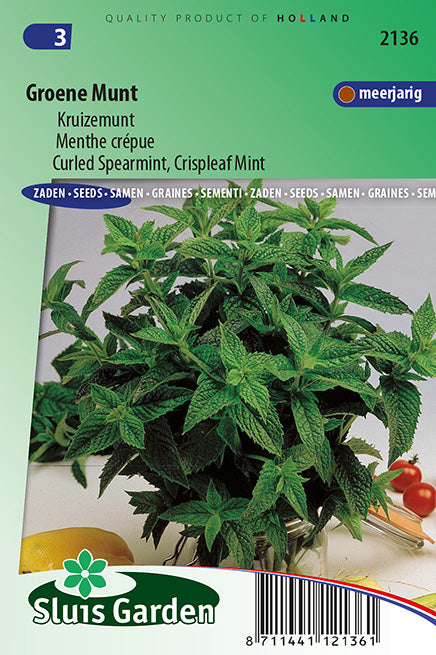1
/
of
1
Curled Spearmint Crispleaf Mint
Curled Spearmint Crispleaf Mint
Regular price
1.350 KWD
Regular price
Sale price
1.350 KWD
Unit price
/
per
Shipping calculated at checkout.
Couldn't load pickup availability
Growing Curled Spearmint, often referred to as Crispleaf Mint, is a delightful way to add a fresh and aromatic herb to your garden. Spearmint (Mentha spicata) is known for its pleasant flavor and is commonly used in culinary applications, beverages, and for its aromatic qualities. Here's a guide on how to grow Curled Spearmint:
**1. Planting Time:**
- Spearmint can be planted in the spring or fall. It's a perennial herb, so once established, it will return year after year.
**2. Soil Preparation:**
- Spearmint prefers well-draining soil with a pH between 6.0 and 7.0. It can tolerate various soil types but thrives in fertile soil. Incorporate organic matter, like compost, to improve soil structure.
**3. Sunlight:**
- Plant Curled Spearmint in a location that receives partial shade to full sunlight. It can tolerate some shade but prefers at least 4-6 hours of sunlight per day.
**4. Propagation:**
- Spearmint is often propagated from cuttings or division. Spring is an ideal time for planting. You can also grow it from seeds, but it's faster to start with established plants.
**5. Spacing:**
- Space Spearmint plants about 18-24 inches apart to allow for their spreading growth habit.
**6. Watering:**
- Keep the soil consistently moist, especially during the growing season. Spearmint prefers slightly damp conditions. Water when the top inch of soil feels dry.
**7. Fertilization:**
- Spearmint doesn't require heavy fertilization. A balanced, all-purpose fertilizer applied in the spring is usually sufficient.
**8. Mulching:**
- Apply a layer of mulch around the base of Spearmint plants to help conserve soil moisture and suppress weeds.
**9. Pruning:**
- Regularly prune Spearmint to control its spreading growth and maintain a more compact shape. You can trim it back after flowering to encourage bushier growth.
**10. Companion Planting:**
- Spearmint can repel certain pests. Consider planting it near vegetables or plants that are susceptible to insect pests.
**11. Harvesting:**
- Harvest Spearmint leaves as needed once the plant has reached a sufficient size. The leaves are often used fresh or dried for culinary purposes, teas, or aromatherapy. Harvest in the morning when the oils are most concentrated.
**12. Winter Care:**
- Spearmint is hardy in many climates and can withstand cold temperatures. In colder climates, it may die back in winter but will regrow in the spring. Apply a layer of mulch for added protection.
**13. Pests and Diseases:**
- Spearmint is generally resistant to pests and diseases. However, it can attract beneficial insects, making it a good addition to a garden.
Growing Curled Spearmint can provide you with a steady supply of fresh leaves for various culinary uses and aromatic pleasures. Enjoy the process of cultivating this versatile herb!
**1. Planting Time:**
- Spearmint can be planted in the spring or fall. It's a perennial herb, so once established, it will return year after year.
**2. Soil Preparation:**
- Spearmint prefers well-draining soil with a pH between 6.0 and 7.0. It can tolerate various soil types but thrives in fertile soil. Incorporate organic matter, like compost, to improve soil structure.
**3. Sunlight:**
- Plant Curled Spearmint in a location that receives partial shade to full sunlight. It can tolerate some shade but prefers at least 4-6 hours of sunlight per day.
**4. Propagation:**
- Spearmint is often propagated from cuttings or division. Spring is an ideal time for planting. You can also grow it from seeds, but it's faster to start with established plants.
**5. Spacing:**
- Space Spearmint plants about 18-24 inches apart to allow for their spreading growth habit.
**6. Watering:**
- Keep the soil consistently moist, especially during the growing season. Spearmint prefers slightly damp conditions. Water when the top inch of soil feels dry.
**7. Fertilization:**
- Spearmint doesn't require heavy fertilization. A balanced, all-purpose fertilizer applied in the spring is usually sufficient.
**8. Mulching:**
- Apply a layer of mulch around the base of Spearmint plants to help conserve soil moisture and suppress weeds.
**9. Pruning:**
- Regularly prune Spearmint to control its spreading growth and maintain a more compact shape. You can trim it back after flowering to encourage bushier growth.
**10. Companion Planting:**
- Spearmint can repel certain pests. Consider planting it near vegetables or plants that are susceptible to insect pests.
**11. Harvesting:**
- Harvest Spearmint leaves as needed once the plant has reached a sufficient size. The leaves are often used fresh or dried for culinary purposes, teas, or aromatherapy. Harvest in the morning when the oils are most concentrated.
**12. Winter Care:**
- Spearmint is hardy in many climates and can withstand cold temperatures. In colder climates, it may die back in winter but will regrow in the spring. Apply a layer of mulch for added protection.
**13. Pests and Diseases:**
- Spearmint is generally resistant to pests and diseases. However, it can attract beneficial insects, making it a good addition to a garden.
Growing Curled Spearmint can provide you with a steady supply of fresh leaves for various culinary uses and aromatic pleasures. Enjoy the process of cultivating this versatile herb!
Share

